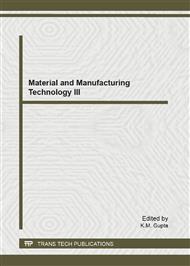[1]
Hodgett, D .L., Efficient drying using heat pump, Chemical Engineer, pp.510-512. July/August, ( 1976).
Google Scholar
[2]
Rossi, S.J., Neues, L.C. and Kicokbusch, T. G, Thermodynamic and energetic evaluation of a heat pump applied to the drying of vegetables, Drying '92 , Ed., Mujumader, A. S., Elsevier science, pp.1475-1478. (1992).
Google Scholar
[3]
Birchall, S., Heat pump drier-investigating energy efficiency, Proceedings Development and Application of Heat Pump Drier, Brisbane, 7 pages, March (1993).
Google Scholar
[4]
Mason, R.L. and Blarcom, A. V., Drying macadamia nuts using a heat pump dehumidifier, Proceedings on Development and Application of Heat Pump Drier, 7 pages, March , (1993).
Google Scholar
[5]
Prasertsan, S. and Saen-Saby, P., Heat pump drying of agricultural materials, Drying Technology, 16, pp.235-250. Vol. (1998).
DOI: 10.1080/07373939808917401
Google Scholar
[6]
Gao, G. C. and Wang, J .F., Experiment study on the performance of heat pump unit used for food drying, New Energy Resources, (1999), ( in Chinese).
Google Scholar
[7]
Prasertsan, S., Saen-Saby, P., Ngamsritrakul, P. and Prateepchaikul, G., Heat pump dryer Part 1: simulation of the models, International Journal of Energy Research, Vol. 20, pp.1067-1079, (1996).
DOI: 10.1002/(sici)1099-114x(199612)20:12<1067::aid-er229>3.0.co;2-g
Google Scholar
[8]
Pendyala, V.R., Devotta, S. and Patwardhan, V. S., Heat-pump-assisted dryer Part 2: Experiment study, International Journal of Energy Research, Vol. 14, P. 493-507., (1990).
DOI: 10.1002/er.4440140503
Google Scholar
[9]
Hawlader, M. N. A., Chou, S. K. and Chua, K.J., Development of design charts for tunnel dryers, International Journal of Energy Research, Vol. 21, P. 1023-1037., ( 1997).
DOI: 10.1002/(sici)1099-114x(199709)21:11<1023::aid-er309>3.0.co;2-a
Google Scholar
[10]
Alves-Filho, Odilio. and Strommen, Ingvald., The application of heat pump in drying of Biomaterials, Drying Technology, 14(9), P. 2061-2090, (1996).
DOI: 10.1080/07373939608917196
Google Scholar


